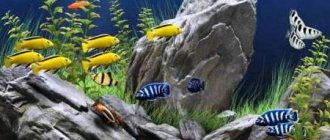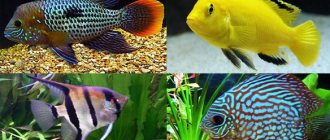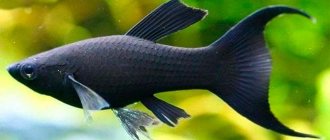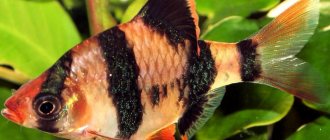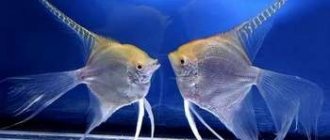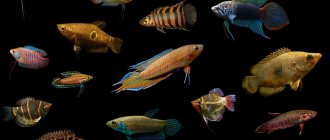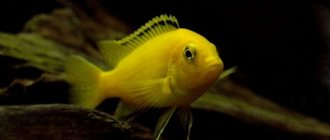| American cichlids | African cichlids |
Articles
:
How to determine the sex of your cichlids?
The question of determining the sex of fish worries many. The proposed methods are not always 100% reliable, however, we will bring to your attention several of the most reliable ones.
If your cichlids are dimorphic (that is, the coloring and body markings of males and females are significantly different), the task is quite simple. Then you just need to find photographs of males and females of a given species and compare the inhabitants of your aquarium with them. If sexual dimorphism is not obvious, or your cichlids are a monomorphic species, you will need to do the following to determine sex: Perform an “examination.” With wet hands (necessarily wet, otherwise you can “burn” the fish, for which a temperature of 36.6 degrees is fatal), you should take out the fish and, turning it belly up, inspect it. Between the anus and the anal fin there is an opening - the genital papilla (ovipositor in females). During spawning, females release eggs through this hole, and males release seeds. Females have a larger genital opening than males (since females release fairly large eggs). When determining sex in this way, difficulty arises with representatives of species that lay eggs in the substrate (for example, Neolamprologus), since their eggs are relatively small in size, that is, the sizes of the genital openings of males and females are almost the same.
In some cases, individuals of different sexes have special pigmentation in the area of the genital opening; in others (in the case of the Julidochromis species) - in males the genital papilla protrudes slightly, that is, if you run your finger in the area where it is located, you can feel it.
I remind you once again that your hands must be wet. However, you should not hold the fish in the air for more than 30 seconds. It is also recommended to carry out the inspection no more than 3 times, so as not to stress the fish.
Other methods of sex determination (less reliable than “examination”) are, for example, observation of behavior, differences in size, differences in body and fin shape, and the presence or absence of egg spots on the anal fin. Most males of species whose females carry eggs in their mouths have at least one egg spot on the anal fin. However, often females also have egg spots; In only a few species, this “privilege” of having spots on the fin falls only on males.
When looking at size, it should be noted that in most cases, the males of the cichlid species found in Malawi are larger than the females. Another distinctive feature of most males is that the ends of their fins are pointed, while the tips of the fins of females are rounded.
The only reliable way to determine the sex of your fish is to “inspect” the genital area. You can, of course, wait until maturity and the spawning period, but if your cichlids are already 4 months old or more and you want to know how many females and males you can expect, determine their gender.
Source
Labidochromis Yellow
LABIDOCHROMIS YELLOW
In this article we will talk about probably the most popular endemic of Lake Malawi from the Mbuna group - Labidochromis Yellow! It is worth noting that there are quite a lot of color variations of Labidochromis: from white to blue, but it is this yellow color that aquarists love most. These fish have earned popular love not only for their bright colors, but also for their unpretentious keeping, resistance to diseases, interesting behavior and absolutely unproblematic breeding.
Let's take a closer look at these amazing fish.
Latin name: Labidochromis caeruleus "yellow";
Russian name: Labidochromis yellow;
Synonyms: Yellow, labidochromis yellow, golden, yellow, labidochromis yellow, labidochromis lemon, labidochromis hummingbird;
Order, family: cichlids or cichlids (Cichlidae);
Habitat: Africa, lake endemics. Malawi, Mbuna group. They live in the waters of the western coast of the lake along rocky, coastal coastlines, at a depth of 10-50 meters - in shallow water. Despite its wide distribution in the lake, wild specimens of labidochromis are very rarely found with a yellow color. Yellow forms of fish are found only in the northern part of the lake, between Lev and Charo bays.
How long does Labidochromis yellow live: 7-8 years, see how long other fish live - here .
Pseudotropheus demasoni: how to determine the sex of a cichlid, keeping and breeding the fish
Cichlids are distinguished by incredible mobility and curiosity, but no less attract attention with their beautiful appearance. Caring for these creatures is easy and simple. They don't require much attention. The cichlid pseudotropheus demasoni (lat. pseudotropheus demasoni) has a bright blue body. Under natural conditions, it lives in Lake Malawi, which is located in Africa, preferring rocky areas and reservoirs with rocks.
In the initial period, males and females are similar to each other
Compatibility Labidochromis yellow
These yellow cichlids are often called the most peaceful, dwarf cichlids in Africa. Well, one can agree with this opinion; labidochromis really get along well with their own kind. We can say that they are even slightly timid - they hide like mice in holes when there are sudden movements or knocking near the aquarium. However, one should not forget “about the hole of any cichlid.” They should absolutely not be kept with any goldfish, characin fish, labyrinth fish, or viviparous fish. Firstly, this is unnatural - the fish are from different habitats, secondly, the conditions of detention and water parameters vary and thirdly, labidochromis will show aggression towards the more peaceful inhabitants of the aquarium, especially during the spawning period.
Good neighbors for yellow labidochromis will be the same “calm” cichlids, for example, pseudotropheus and blue dolphins. Catfish-like fish (of the armored and loricariid families) get along well with elow - thoracatums, corydoras, ancistrus, L-catfish .
Description of labidochromis yellow
labidochromis in shelter
Fish in nature reach 10 cm in length, in an aquarium they can grow up to 8 cm. The body is dense, elongated, and juicy yellow in color. A black stripe runs along the upper edge of the dorsal fin and along the lower edge of the anal fin, which develops in adult fish and is brightest in males. Males and females do not differ in color. But the dominant male can be easily identified by the intense yellow color of the body, as well as the black ventral and anal fins, which sharply contrast with the general color. The black dorsal fin has a yellow rim. This stripe in adults continues into a black mask and can extend to the stomach. Brown spots appear between the eyes and near the mouth of males.
The color of the ventral and anal fins of females is usually yellow.
Determining the sex of cichlids
Determining the sex of cichlids is one of the most popular questions. This is not always as easy or reliable as we would like, but despite the complexity, there are several ways to determine the sex of fish.
If aquarium fish exhibit dimorphism, that is, the male and female have different colors, the task becomes simpler. All you need to do is find photographs of individuals of this species and compare with them. Sometimes dimorphic fish have subtle differences, making it difficult to determine sex. In this case, the solution to the riddle regarding the sex of an individual is carried out in the same way as for a monomorphic species, in which males and females look the same.
Determining the sex of individuals of a monomorphic species comes down to examining their external genitalia (“venting”). This procedure involves catching a fish, placing it dorsal side down, and examining the genital opening between the anus and the anal fin.
In general, the female has a larger ovipositor compared to the male's genital papilla. This is due to an adaptation to the release of larger eggs. These differences are difficult to determine for species that lay eggs on a substrate (particularly members of the genus Neolamprologus) because their eggs are smaller compared to species that incubate eggs in the mouth.
Genital papilla of the Tanganyikan cichlid Limnochromis auritus. In the male (B), the anus and papilla are the same size; in the female (A), the papilla is slightly larger than the anus (Photo: www.cichlidae.com/forum/viewtopic.php?f=7&t=8720).
The illustration compares the papillae of males and females of some cichlid species.
The anus is located above, and the genital papilla or ovipositor is below (photo: www.fishhead.com/articles/ventsex.htm).
In some cases, members of the same species show differences in genital pigmentation between males and females. In some species, males have an elongated and tapering genital papilla, such as Julidochromis regani. In these males, you can slide your finger through the genital pore from left to right, and the papilla will also move.
When the sex determination procedure is carried out, it is necessary to handle the fish only with wet hands. Fixing the fish through a net or net adds security and prevents the fish from slipping off. Individuals should not be kept in the air for more than 30 seconds. The whole process should be as less stressful as possible; it is advisable to remove the fish from the water no more than three times. Once sex is determined, the individual is placed separately from others of uncertain sex.
Conditions for keeping Labidochromis yellow
The minimum volume of the aquarium should be 100 liters. In such an aquarium you can put three or four females and one male. It is worth noting that such aquarium volumes are very, very small; you will see all the charm and playfulness of these fish only in an aquarium of 200-300 liters. In such volumes you can keep a whole flock of yellows, you can clearly see their hierarchy, habits and courtship!
The design of an aquarium for Labidochromis yellow, in our opinion, should be as natural as possible and imitate the habitat of fish. The aquarium is decorated with heaps of stones, grottoes, and a landscape of gorges and grottoes is created. Yellows stick to the bottom of the aquarium, sheltering their house, this is their patrimony and a subject for territorial showdowns.
At least in the lake. Malawi does not have much driftwood or vegetation, however, mangrove driftwood or grape driftwood will look very beautiful in an aquarium with labidochromis.
There is often an opinion that Vallisnenria , supposedly it is beautiful and serves as an additional diet for the fish. But let me disagree with this! Firstly, Vallisneria is American, it is more suitable for decorating aquariums with South American cichlids (angelfish, discus). Secondly, the gastronomic preferences of yellow simply will not allow Vallisneria to grow and expand, no matter how much you plant it, even if you make thickets, in a month, two of these yellow imps will “mow down” everything to the very roots.
The most successful group of plants for Labidochromis yellow and for cichlids in general are cryptocorynes and anubias . Cichlids do not touch these plants; the plants themselves are unpretentious: they do not require powerful lighting or special conditions.
Appearance and behavior
The body length of these fish is about 6.8 cm, the head is torpedo-shaped. It is also worthy of attention that in the first 60 days of life, females and males are very similar to each other , therefore it is very difficult to determine sex.
Despite their miniature size, these individuals are quite aggressive, so it is not recommended to keep more than 2 fish in one container. In a flock there will always be a dominant male who will attack rivals and injure them. Demasoni cichlids like to swim near rocks, swim into caves and stay there for a long time.
Due to their curiosity, fish have time to study everything that surrounds them, down to the smallest detail. The more stones in the aquarium, various shelters and decorative pots, the more comfortable these creatures feel. They swim in a rather original way: sometimes upside down, sometimes sideways, sometimes just hanging in the water column. It is noteworthy that Demasoni fish are considered vegetarians, that is, they eat exclusively plant foods.
Demasoni live for about 10 years
Keeping and breeding Demasoni involves certain nuances. Active and aggressive - this is how these fish could be briefly described. There are 12 types of them in total. They are distinguished by good health, and therefore get sick extremely rarely. At the same time, injuries are often discovered as they love to fight with each other. If individuals are damaged, you can add table salt or methylene blue to the water.
These fish live up to a maximum of 10 years. Cichlids behave much like saltwater fish when trying to detect a scent. To do this, individuals draw water into their nasal openings and keep it inside for some time.
Feeding and diet of Labidochromis yellow
Fish are omnivores - they eat whatever they give them. They eat dry, frozen and live food perfectly. The diet should include food containing plant components (spirulina granules, you can feed with scalded lettuce or spinach leaves). You can often hear the opinion that you should be wary of feeding labidochromis with live food, in particular bloodworms and tubifex. This supposedly causes “bloating.” However, it is worth noting that feeding any type of fish with live food is potentially dangerous. And the point here is not that this is a protein food that is poorly digested, but that such food can carry pathogenic bacteria that destroy the gastrointestinal tract of fish. You can protect live food and yourself from unnecessary troubles by pre-processing the food. For example, by dropping a couple of drops of methylene blue or iodinol on it.
Feeding any aquarium fish should be correct: balanced, varied. This fundamental rule is the key to the successful keeping of any fish, be it guppies or astronotuses. The article “How and how much to feed aquarium fish” talks about this in detail; it outlines the basic principles of the diet and feeding regime of the fish.
In this article, we note the most important thing - feeding fish should not be monotonous; the diet should include both dry food and live food. In addition, you need to take into account the gastronomic preferences of a particular fish and, depending on this, include in its diet food either with the highest protein content or, conversely, with plant ingredients.
Popular and popular food for fish, of course, is dry food. For example, you can constantly and everywhere find food on aquarium shelves - the leader of the Russian market; in fact, the range of food for this Tetra is included as individual food for a specific type of fish: for goldfish, for cichlids, for loricariids , guppies, labyrinths, arowanas, discus, etc. .d. Tetra has also developed specialized foods, for example, to enhance color, fortified, or for feeding fry. You can find out detailed information about all Tetra feeds on the company’s official website - here .
It should be noted that when purchasing any dry food, you should pay attention to the date of its manufacture and shelf life, try not to buy food in bulk, and also store the food in a closed state - this will help to avoid the development of pathogenic flora in it.
Cichlids
The Cichlid family includes up to 3,000 species, which are distributed throughout the world. Almost half of them live in lakes and rivers of Africa, but colorful fish are also found in the warm rivers of South America and Asia.
They began to breed exotic pets in artificial reservoirs since the times of ancient Egypt, but in Russia and Europe they appeared only in the 20th century, they fell in love with lovers and breeders, who began to breed original and beautifully colored breeds, choosing the most peaceful species.
Cichlids in nature live in fresh or slightly salty lakes and rivers. They belong to the family of ray-tailed fish, the order of perciformes, and have sizes from 2.5 cm to a meter. The main part of Cichlids has a tall body, slightly flattened, with a large head. The commercial breed Tilapia belongs to the same family. The lifespan of fish reaches 10-15 years in an aquarium, in nature up to 20-25 years.
Table of basic parameters of maintenance, care and nutrition:
| What should be the volume of an aquarium for Cichlids? | from 150-300 liters |
| What should be the temperature in the aquarium for Cichlids? | from +20-28 °C |
| What pH should be in the aquarium? | from 6-8 pH |
| What should be the hardness of the water in the aquarium? | from 5-15° dH |
| What should be the substrate for an aquarium? | any |
| What kind of lighting should be in the aquarium? | moderate |
| What should be the movement of water in the aquarium? | moderate |
| Maximum fish size | from 2.5 cm to a meter (depending on the type) |
| What does aquarium fish eat? | depends on the type: aquarium plants; dry food; live food: daphnia, tubifex, bloodworms |
| Type of aquarium fish | aggressive |
| Who is compatible with in an aquarium? | get along with all non-aggressive fish species that do not fit in the mouth |
| Lifespan | up to 10-15 years |
Breeding and propagation of Labidochromis yellow
This question does not present any difficulty. We can say that labidochromis reproduce independently - under optimal conditions, spawning occurs frequently and in a general aquarium. At the same time, even if you didn’t plan to breed yellow ones and didn’t put any effort into it, they will breed on their own... even with aggressive neighbors. Every now and then a couple of fry will survive.
This amazing vitality is due to the intelligence of these fish and the evolutionary habits that they have developed over thousands of years. We recommend that you definitely watch the Animal Planet film “African Cichlids ,” which makes the viewer look at their pets differently.
Diseases: symptoms and treatment
With proper care and good feeding, Cichlids rarely get sick; they are naturally endowed with good health. Changes in living conditions and stressful situations can weaken their natural immunity and lead to illness. Hypothermia, the presence of chlorine, excessive water hardness, and poor nutrition have a negative impact on the health of fish.
Most often they suffer from ichthyophthoriosis, caused by a parasitic ciliate. At the same time, the fins can dry out and become deformed, the fish scratches itself on objects and becomes restless. The treatment is simple: place the fish in salted water (10 g per liter of water) for a few minutes, repeat if necessary. It is important to treat all the inhabitants of the aquarium and then refresh the water.
In the photo, the sexual differences between the male and female Labidochromis yellow
The spawning process itself in labidochromis is typical.
The male finds a “secluded place” and often digs a hole where the female lays her eggs. After the eggs are fertilized, the female incubates it in her mouth for a month (24-40 days). At the end of this period, completely independent juveniles (10-30 tails) are born. Usually the female guards and protects her offspring for another week, and then releases them “to swim freely.”
All of the above is just the fruit of observing this type of aquarium fish and collecting various information from owners and breeders. We would like to share with visitors not only information, but also live emotions that allow us to understand the world of aquariums more fully and subtly. Register at https://fanfishka.ru/forum/ , participate in discussions on the forum, create profile topics where you will talk about your pets in the first person and first-hand, describe their habits, behavioral features and content, and share with us your successes and joys, share your experiences and learn from the experiences of others. We are interested in every bit of your experience, every second of your joy, every awareness of a mistake, which makes it possible for your comrades to avoid the same mistake. The more of us there are, the more pure and transparent drops of goodness there are in the life and everyday life of our seven billion society.
Breeding Features
Sexual maturity of fish occurs at the age of 6 to 8 months. Reproduction of fish in an aquarium occurs without problems. After the formation of a pair, the male chooses a quiet place for spawning and digs a hole in the ground there (at this moment it is easy to distinguish the male from the female). The female lays eggs in it, and when they are fertilized, she collects them and incubates them in her mouth. The fry appear after 24-40 days. After hatching, the juveniles are quite independent.
During reproduction, the female holds the offspring in her mouth for a long time, as a result of which she does not eat and loses a lot of weight.
The female takes care of and protects them for a week after the appearance of the fry, after which she loses interest in the offspring. The high intelligence of the species allows several fry from the brood to survive even among aggressive neighbors, which is why, under the right conditions of keeping, Labidochromis Yellow will definitely breed in the aquarium.
When fish are purposefully bred, young animals should be fed with small crustaceans and special dry food. If there is no desire to get offspring from fish, they do not pay attention to the fry in the aquarium. They eat the leftover food for adult fish and grow quite well on this diet. The owner of a yellow cichlid should be prepared for the fact that they will definitely breed and it will be impossible to stop this process. Small pet stores are often willing to accept excess animals.
Video: Spawning of labidochromis yellow
A selection of beautiful photos of Labidochromis yellow
Labidochromis Yellow: care, breeding, compatibility, photos and videos
Labidochromis yellow (lat. Labidochromis caeruleus) is a dwarf fish of the Cichlid family (Cichlids), belongs to the genus Mbuna . Other names: yellow labidochromis, hummingbird cichlid, Tanganyika fish, Canary cichlid. In fact, there are more than a dozen scale color options. In the natural environment, they live on a rocky bottom; they are territorial in nature, but less aggressive towards cichlids that have a dull color.
Labidochromis yellow was first described in the 50s of the twentieth century. As a member of the Mbuna genus, it is endemic to the African Lake Malawi. Due to its wide habitat in different parts of the lake, Labidochromis has a wide variety of external colors: from white to lemon yellow and blue. Labidochromis yellow "electric" is found only off the coast of Nkata Bay, and in the areas of Lions Cove and Charo Islands. Mbuna cichlids live at a depth of 10-30 meters with a rocky bottom. They live in pairs or alone. The diet consists of live food.
Detailed description of the labidochromis yellow fish or yellow cichlid
In this article I will talk about a small yellow fish - yellowfish, otherwise known as cichlids. I will highlight the description and features, and also tell you what conditions are needed for keeping it in an aquarium.
It is important to know about the proper nutrition of an individual, so I will talk in detail about feeding. I will list several species of fish with which the cichlid gets along, and which ones should not be allowed to live together. I will focus on breeding and reproduction.
Description and features of Labidochromis yellow
Among the dwarf peaceful fish, yellow cichlids stand out. Aquatic animals live up to 7-8 years. Their length does not exceed 10 cm, but in an aquarium they do not grow more than 8 cm.
The fish have a dense body, they are characterized by an elongated shape, and their scales are a rich yellow color. Aquatic inhabitants - female and male yellowtails - wear the same shade, so they cannot be distinguished by color.
The dominant has brown spots, they are clearly visible between the eyes, as well as near the mouth. Favorable water temperature is considered to be 24-28 degrees.
The fish is characterized by an elongated shape and bright color.
Yellow fish occupy rocky lines near the base of the banks, they live at a depth of 10-40 meters, they are often found in the thickets of Vallisneria and are called: yellow labidochromis, as well as Tanganyika and yellow labidochromis.
Cichlids: how to keep and what to feed, reproduction and how to distinguish a male from a female
Author: Yulia Ryabchenko · Published 03/10/2020 · Updated 11/27/2020
Cichlids are loved by home aquarium owners for their diversity of species, bright colors and unusual habits. This is the only fish capable of recognizing its owner and carefully caring for its offspring.
In addition, family values are not alien to her, because this fish chooses a partner for life. Cichlids can breed in an aquarium and live quite a long time.
Conditions for keeping a yellow cichlid in an aquarium
- To breed and maintain healthy individuals, it is necessary to provide large and spacious aquariums with a capacity of 250 liters or more .
- The sex ratio should be distributed correctly, from 3-6 females to 1 male .
- The water should be hard and the alkaline environment should not exceed the pH limits of 7.6-8.6.
- Carefully work on the decorative design and provide for the natural habitat.
Fish do well among rocky bases, where they can hide and spawn. Individuals love freedom, so they should have a lot of space. Coarse limestone is necessary for the soil substrate; in addition, sand and small corals are used, all of which is sprinkled with marble chips.
It is advisable to provide thickets and place a tree in the aquarium to propagate them. Cyclids grow well in clean water, free of ammonia and nitrates. It is better to use a powerful external filter, change the water on time, and do not forget to siphon the bottom.
You can use small pebbles or marble chips as soil.
Content recommendations
The compatibility of Pseudotropheus demasoni is quite problematic. You should not keep them together with other inhabitants of the reservoir. Cichlids can even attack neighbors that are significantly larger than them.
The best option is to place a male and a female in the aquarium. Another possible solution is to house them with mbunas (also cichlids) of other colors. They can coexist, but only if the bottom is rocky. Demasoni definitely requires personal space.
Sand can be safely placed on the bottom
These creatures are incompatible with fish, which have similar body coloring. If it is not possible to place one male and one female in the aquarium, you can place them in groups of 10 individuals, but there should always be only one male. You can put on the bottom:
- pieces of stone;
- coral crushed stone;
- sand.
If possible, artificial caves and grottoes should be created. The container with fish should have a capacity of 200 liters. The water can be fresh, but it is better if it is brackish, then the individuals will feel comfortable.
Other requirements for conditions:
- temperature regime - 24-28 degrees Celsius;
- acidity pH - 7.5−8.6;
- lighting is moderate.
Water filtration is of great importance. It must be changed in a timely manner. To ensure the optimal level of hardness, arcanite sand, marble and coral chips are used. Pisces like jewelry made from stones.
Feeding the fish
The omnivorous yellowfish feeds on plants and algae, and eats insects and snails. The diet includes small crustaceans and mollusks.
With the help of small and pointed teeth, labidochromis can easily reach prey from small cracks. To feed fish, it is necessary to provide products based on ingredients of plant origin.
Do not forget about plant foods, consisting of peeled peas and salad, you can add spinach. Yellow fish often experience bloating in their abdomen, which is practically untreatable and ultimately causes death. You should not give bloodworms or tubifex to individuals, they are dangerous to health.
What to feed cichlids
It is important to feed this breed of fish correctly. First of all, you should study what type of food is suitable for a given species, carnivorous, herbivorous or omnivorous. You cannot feed Cichlids only with dry food; the fish need live food.
Herbivorous species happily eat chopped lettuce, spinach, and dandelion; they will not refuse vegetables: cucumber, zucchini, carrots.
Predators need live food, that is, protein food: live bloodworms, cortera, chopped squid, fish, grated beef heart or liver. Omnivorous species consume 30% protein foods, 70% plant foods.
What to feed the fry
The fry that have just emerged from the eggs are fed with ciliates, daphnia, sedge; when they grow up, they are fed with daphnia, live crushed bloodworms, and ready-made food.
Compatibility with other types
At home, for breeding individuals, they provide relatives who coexist peacefully with cichlids. Acaras are suitable among such fish. Sometimes African cichlids fight with Tanganyika fish. To avoid collisions, small fish are added to the individuals and underwater reefs are established.
Yellowfish often do not perceive aquatic animals that have the same color and body shape.
Large species live well in pairs. For example, African and American fish are bred. Yellowfish often do not perceive aquatic animals that have the same color and body shape.
In the neighborhood they live well with:
- lamprologus
- aulonocara
- sonodontis catfish
Aquarium fish Cichlids: maintenance and care
Breeders have bred a large number of species of Cichlids, differing from each other in appearance, body shape and habits. Fish can be painted in a wide variety of colors: white, pearlescent, blue, green, pink. Different species have their own patterns on the sides: longitudinal or transverse stripes, specks, dots. The body shape of different species is different: elongated, circular, flat. The character of the fish is also not the same; they can be quarrelsome and peaceful.
Caring for Cichlids is not too complicated, but it requires following some rules:
You should not plant aquarium plants in the tank, the fish will tear them to pieces. It is worth giving preference to artificial bushes; it is better to pour sand on the bottom. A lid with artificial lighting should be installed on top; the light should be diffused and not too bright.
